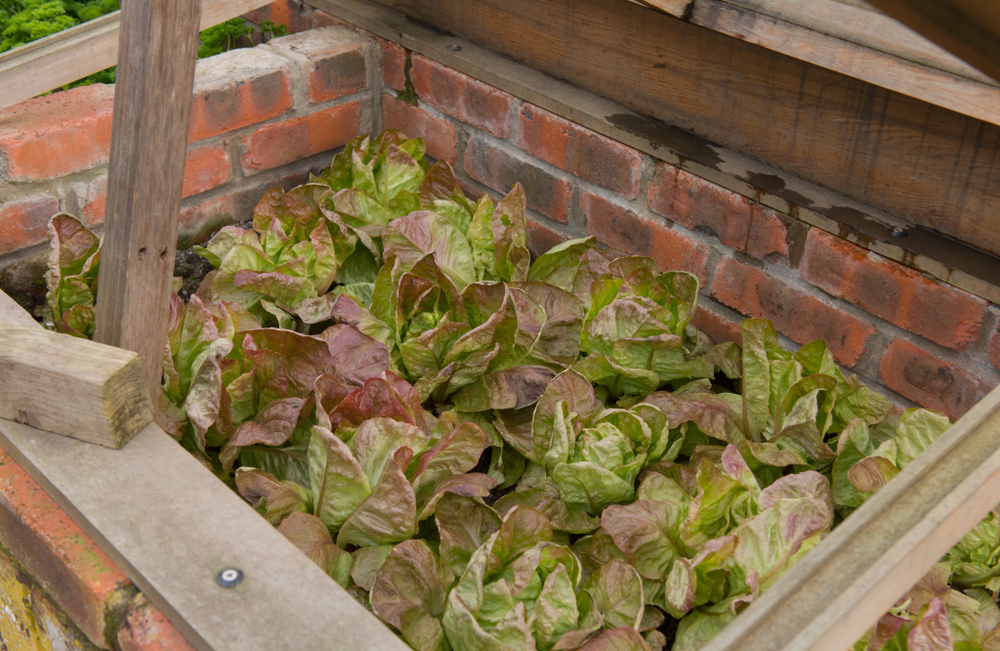
Image Source: Shutterstock
Fall frosts don’t have to end your salad season. With the right cold frame, you can extend lettuce production well into winter. Cold frames act like mini greenhouses, trapping daytime warmth and protecting tender greens from overnight freezes. Even simple designs can raise soil temperatures just enough to keep cool-weather crops thriving. Whether you’re growing on a patio or in a backyard bed, here are seven cold frame styles that keep lettuce crisp, sweet, and harvest-ready long after the first frost.
1. Classic Wooden Cold Frame with Glass Lid
A sturdy wood frame with a repurposed window on top remains a gardener’s favorite. It’s simple and effective. Angled glass lids maximize sunlight while shedding snow. Cedar or redwood frames resist rot and hold warmth overnight. Open the lid slightly on sunny days to prevent overheating. This timeless style is ideal for raised-bed gardeners.
2. Lightweight PVC Hoop Frame
PVC hoop cold frames are quick, affordable, and portable. Just bend flexible PVC pipes over garden beds, covering them with heavy greenhouse plastic, and securing the ends with clamps. These domed structures trap heat efficiently. Plus they allow easy access for watering. Use this method if you need season-extension on a budget or you plan to move frames between beds.
3. Recycled Window-Pane Cold Frame
If you value sustainability, salvaged materials make great cold frames. Old windows, shower doors, or skylight panels can be repurposed into sturdy covers. Most of these items you can find in a salvage yard. These glass-topped frames retain heat better than plastic, giving lettuce steady warmth during temperature dips. Just check that old panes are free from lead paint before use.
4. Double-Layer Polycarbonate Frame
If you want professional-grade insulation, opt for a double-walled polycarbonate cold frame. Polycarbonate has the ability to diffuse sunlight evenly while preventing cold spots. It’s lightweight but tough. The material can resist hail, wind, and snow. Double layers trap even more air, which acts as insulation. Use this method if you’re a northern gardener who wants to keep lettuce alive through December or beyond.
5. Raised-Bed Cold Frame Kit
Did you know that you can buy a pre-built kit? These usually combine a raised planter box with a hinged lid. This blends access and heat retention. Retail versions can also include automatic venting arms that open when temperatures rise. If you don’t have time to build your own, these pre-built kits can be very helpful.
6. Straw-Bale Cold Frame
For an ultra-cheap and eco-friendly solution, stack straw bales in a rectangle and cover the top with an old window or clear plastic. Straw acts as natural insulation, storing solar heat during the day and releasing it slowly at night. This setup is temporary but surprisingly effective for late-season greens. Once spring arrives, the decomposing straw doubles as compost for next season’s beds.
7. Portable Mini-Greenhouse
When convenience matters most, collapsible mini-greenhouses with zippered covers offer quick protection. Portable cold frames are ideal for patios or small gardens where space is limited. These lightweight models can be moved to chase the sun or shield plants from wind. They’re especially handy for lettuce transplants that need extra warmth in early spring or late fall.
Extending the Harvest Naturally
Cold frames transform chilly months into productive growing time. Lettuce, spinach, and arugula thrive when given steady protection from frost and wind. With one of these seven options, you can keep harvesting crisp greens while neighbors pack up their gardens for winter. A few simple boards, panels, or bales can mean fresh salads all season long.
Have you tried building your own cold frame? Share your design ideas or results in the comments.
You May Also Like…
- 9 Edible Weeds That Pop Up in September
- Why Over-Fertilizing Kills More Plants in Fall
- 10 Ways Fallen Leaves Feed Your Soil
- How to Harden Off Plants Before the First Frost
- 7 Native Shrubs to Plant Before the Ground Freezes

Teri Monroe started her career in communications working for local government and nonprofits. Today, she is a freelance finance and lifestyle writer and small business owner. In her spare time, she loves golfing with her husband, taking her dog Milo on long walks, and playing pickleball with friends.
Leave a Reply